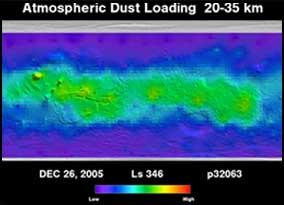Monitoring Atmospheric Temperatures and Dust

FORECAST: DUST
Daily maps such as this showing dust in the atmosphere help mission engineers know how deep newly arrived orbiter spacecraft can dive into the atmosphere to adjust their orbits by aerobraking.
NASA/JPL/Arizona State University
Download OriginalWhenever orbiter and lander spacecraft arrive at Mars from Earth, mission controlers need to know the state of the Martian atmosphere: How high does it extend? How dusty is it? How dense are its layers at specific altitudes?
To get landers such as NASA's Mars Exploration Rovers and its Phoenix Mars Scout down safely on the ground, flight engineers need updated atmospheric profiles. These tell them when to open the parachutes for best effectiveness.
Orbiters such as NASA's Mars Odyssey and Mars Reconnaissance Orbiter face a related problem. With these, mission controlers want to save fuel for science operations later in the mission. So they direct the spacecraft to spend its first few months in orbit making repeated dips through the outer Martian atmosphere, a process called aerobraking. The resulting drag adjusts the shape and size of the spacecraft's orbit for free.
To aerobrake safely, flight engineers have in the past used data from the Thermal Emission Spectrometer (TES), a mineral-mapping instrument on NASA's Mars Global Surveyor orbiter. Besides minerals, TES also measured the dust content and temperature of the atmosphere. Unfortunately, when the Mars Global Surveyor was lost in November 2006 after a 10-year mission, scientists also lost TES.
Before losing contact, however, scientists had made simultaneous observations of atmospheric dust using both TES and the Thermal Emission Imaging System (THEMIS) on Mars Odyssey. Although THEMIS is not primarily an atmospheric instrument, researchers at the Mars Space Flight Facility used the simultaneous measurements to develop a cross-calibration method. This lets THEMIS now yield data that formerly only the now-silent TES could provide.